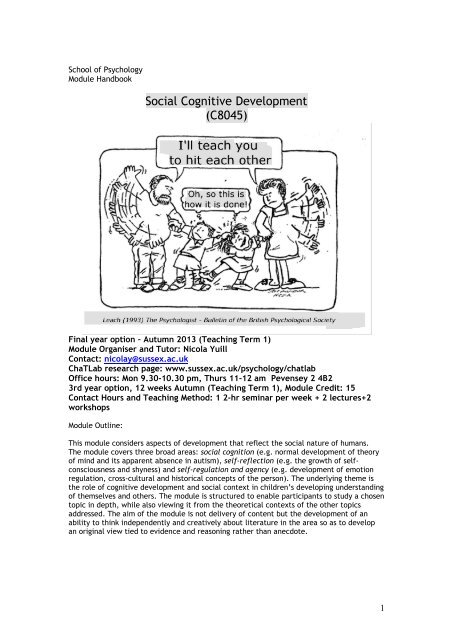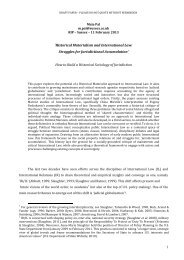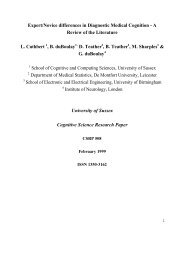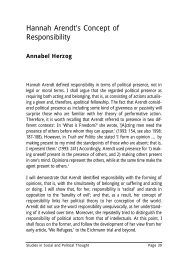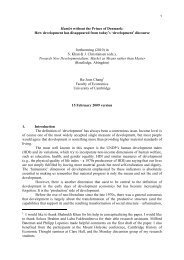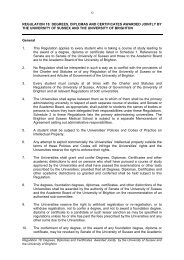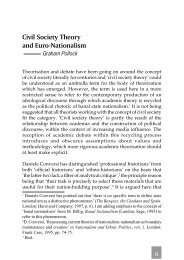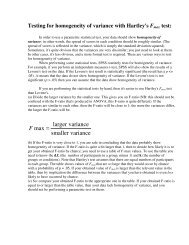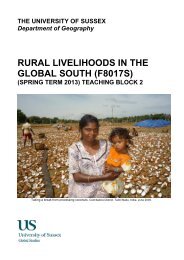Social Cognitive Development handbook 13-14 - University of Sussex
Social Cognitive Development handbook 13-14 - University of Sussex
Social Cognitive Development handbook 13-14 - University of Sussex
You also want an ePaper? Increase the reach of your titles
YUMPU automatically turns print PDFs into web optimized ePapers that Google loves.
School <strong>of</strong> Psychology<br />
Module Handbook<br />
<strong>Social</strong> <strong>Cognitive</strong> <strong>Development</strong><br />
(C8045)<br />
Final year option – Autumn 20<strong>13</strong> (Teaching Term 1)<br />
Module Organiser and Tutor: Nicola Yuill<br />
Contact: nicolay@sussex.ac.uk<br />
ChaTLab research page: www.sussex.ac.uk/psychology/chatlab<br />
Office hours: Mon 9.30-10.30 pm, Thurs 11-12 am Pevensey 2 4B2<br />
3rd year option, 12 weeks Autumn (Teaching Term 1), Module Credit: 15<br />
Contact Hours and Teaching Method: 1 2-hr seminar per week + 2 lectures+2<br />
workshops<br />
Module Outline:<br />
This module considers aspects <strong>of</strong> development that reflect the social nature <strong>of</strong> humans.<br />
The module covers three broad areas: social cognition (e.g. normal development <strong>of</strong> theory<br />
<strong>of</strong> mind and its apparent absence in autism), self-reflection (e.g. the growth <strong>of</strong> selfconsciousness<br />
and shyness) and self-regulation and agency (e.g. development <strong>of</strong> emotion<br />
regulation, cross-cultural and historical concepts <strong>of</strong> the person). The underlying theme is<br />
the role <strong>of</strong> cognitive development and social context in children’s developing understanding<br />
<strong>of</strong> themselves and others. The module is structured to enable participants to study a chosen<br />
topic in depth, while also viewing it from the theoretical contexts <strong>of</strong> the other topics<br />
addressed. The aim <strong>of</strong> the module is not delivery <strong>of</strong> content but the development <strong>of</strong> an<br />
ability to think independently and creatively about literature in the area so as to develop<br />
an original view tied to evidence and reasoning rather than anecdote.<br />
1
Module Objectives:<br />
1) to enable you to work in depth on a particular topic that interests you<br />
2) to reflect in a constructive and critical way on some basic theoretical questions about<br />
developmental psychology and social cognition<br />
3) to develop your skills in independently choosing, specifying and researching a topic.<br />
4) to develop your abilities to present your research orally in a way that considers the<br />
needs <strong>of</strong> your audience, including choosing introductory readings<br />
5) to develop your skills in listening and responding constructively to others’ presentation<br />
Pre-requisites: 2nd year <strong>Development</strong>al Psychology or equivalent, knowledge <strong>of</strong> basic<br />
theories <strong>of</strong> cognitive and social development (e.g. Piaget, Vygotsky, language development)<br />
Learning Outcomes: by the end <strong>of</strong> the module a successful student should be able to:<br />
--demonstrate a clear understanding <strong>of</strong> theories relevant to social cognitive development<br />
--demonstrate an ability to critically evaluate empirical evidence, core concepts and<br />
controversies in social cognitive development<br />
--demonstrate the ability to construct a topic-relevant argument in speech and writing<br />
Assessment:<br />
1. Seminar presentation with advance summary and slides on Study Direct: Weighted 30%<br />
2. Essay outline one week following the presentation: Not weighted (for feedback only)<br />
3. Extended essay (3,000 words) Weighted 70%. Deadline on <strong>Sussex</strong> Direct.<br />
V&E assessment: Please contact the Psychology Office re assessment if you leave before the<br />
year-end.<br />
Assessment criteria at<br />
www.sussex.ac.uk/psychology/internal/schoolinformation/examinationsandassessment<br />
Please make sure you are familiar with the rules on assessment, submission, late submission<br />
and submission <strong>of</strong> evidence.<br />
Plagiarism is not tolerated: http://www.sussex.ac.uk/academic<strong>of</strong>fice/plagiarism<br />
Method <strong>of</strong> Student Feedback: Anonymous questionnaire, reported on at Psychology School<br />
meeting and in subsequent module report. I welcome your feedback throughout the<br />
module: quicker feedback means speedier response, and every year improvements are<br />
made as a result <strong>of</strong> such feedback.<br />
Module timetable: full details on <strong>Sussex</strong> Direct<br />
Wk1 Wk2 Wk3 Wk4 Wk5 Wk6 Wk7 Wk8 Wk9 Wk10 Wk11 Wk12<br />
Sem1 Lec Wkshop Sem2 Sem3 Sem4 Sem5 Sem6 Sem7 Sem8 Sem9 Wkshop<br />
Lec 1 2<br />
The sequence <strong>of</strong> topics for each week is decided by the end <strong>of</strong> Week 2.<br />
Topics are (NOT necessarily in this order)<br />
Emotion: Display rules, self-presentation and culture<br />
Concepts <strong>of</strong> the person: Cultural and historical<br />
Theory <strong>of</strong> mind: cognition, emotion and language<br />
Theory <strong>of</strong> mind and atypical development: autism, deafness, blindness<br />
<strong>Social</strong> cognition: Role <strong>of</strong> family, friends and culture<br />
Morality: Empathy and psychopathy<br />
Self and other understanding: the case <strong>of</strong> autism<br />
Shyness, inhibition and disinhibition<br />
2
Details <strong>of</strong> coursework requirements<br />
1. Seminar presentation with advance summary<br />
Due: The presentation takes place at the seminar as shown on the list posted on the Study<br />
Direct site by 1 st October 20<strong>13</strong>.<br />
The advance summary (see below) must be posted on Study Direct and emailed to your<br />
tutor by 5pm the Friday before your seminar.<br />
Format: An advance summary, approx 250 words, explaining the question you will address<br />
and possible issues for discussion, with two suggested short readings AND<br />
A 12-minute oral presentation followed by management <strong>of</strong> a group discussion. Criteria for<br />
marking include depth <strong>of</strong> coverage, logic <strong>of</strong> argument, critical analysis, clarity <strong>of</strong><br />
presentation, effective use <strong>of</strong> examples/visual aids or other demonstrations (including<br />
advance summary), and effective management <strong>of</strong> discussion. Tips are given below.<br />
Please note the following:<br />
Seminar presentations must be given on the date agreed in advance with the<br />
module convenor. If you are unable to give your presentation on the agreed date<br />
but feel that there are mitigating circumstances, you can submit a claim in the<br />
usual way: http://www.sussex.ac.uk/studentlifecentre/mitigation<br />
<br />
On the day <strong>of</strong> your presentation, please ensure that you submit a copy <strong>of</strong> your<br />
presentation slides (6 to a page is acceptable) to the School Office so that we can<br />
record your presentation date and feedback release date.<br />
2. Essay outline<br />
Due: Submit one copy <strong>of</strong> an essay outline to the tutor at the seminar following your<br />
presentation. This is an unweighted assessment (not contributing to the final module mark),<br />
but is a crucial opportunity for you to receive feedback on your ideas as you prepare for<br />
your extended essay.<br />
Format: Maximum 750 words, no more than 2 A4 sides in note or diagram form. The<br />
outline should normally follow on from ideas discussed and developed in your presentation –<br />
that is, it brings in new ideas or information as a result <strong>of</strong> discussion and further reading.<br />
You can also use it as early preparation for your extended essay. Tips are given below.<br />
3. Extended essay (3,000 words)<br />
Due: After the module has finished, date as advised on <strong>Sussex</strong> Direct.<br />
Format: As advised in the <strong>handbook</strong> for candidates. Tips are given below.<br />
The module is designed so that you can investigate a chosen topic in depth, and thus<br />
develop your ability to formulate your own informed opinion by thinking critically and<br />
constructively, from a firm base in empirical and theoretical work in your chosen area. This<br />
means that your presentation and your extended essay can be in the same field <strong>of</strong><br />
investigation. Your extended essay should involve a detailed examination <strong>of</strong> how theory<br />
and research can help us answer a specific question about social cognitive development.<br />
Developing your ability to argue coherently and to master issues in social cognitive<br />
development will be helped if you engage in constructive and critical discussion in all the<br />
seminar presentations through the module. Previous experience shows that best marks are<br />
achieved by students who participate actively in all seminars.<br />
3
How to get the best from the module:<br />
Tips on seminar presentation:<br />
The advance summary has three important aims:<br />
-- to ensure that you have a coherent argument to present<br />
-- to ensure everyone does some advance preparation so that the discussion is well<br />
informed and thoughtful<br />
-- to provide reading on basic material, so that your presentation does not need to cover<br />
basic description and background.<br />
The summary should tell the group what area you will cover and should present a specific<br />
question, issue, or position that you will argue. It must provide one or two short readings<br />
that will give the group background to enable good participation in the seminar.<br />
There are some real (slightly doctored) examples <strong>of</strong> advance summaries and <strong>of</strong> essay<br />
outlines with my comments, on the Study Direct site. They are not ‘ideal’ but ‘typical’. The<br />
presentation feedback sheet with marking criteria is also available on the site.<br />
Your presentation mark includes credit for how you try to engage the audience. You might<br />
give them questions to think about at the outset, handouts or an overhead that help<br />
structure their thoughts and/ or their written notes as they listen to your presentation.<br />
Tips on Essay Outline<br />
Essay Question<br />
(a) A summary <strong>of</strong> the introductory paragraph, which will orient the reader to what you are<br />
trying to do and how you intend to do it. This tells the reader what to expect and also sets the<br />
criterion <strong>of</strong> relevance against which they can judge whether or not your essay achieves what<br />
it sets out to do. [This section]… should:<br />
highlight the terms from the title that you believe are important;<br />
make clear how you are interpreting the question;<br />
state your aims;<br />
and very briefly indicate the general line <strong>of</strong> argument and/or order <strong>of</strong> discussion that<br />
follows. [….]<br />
(b) In the order in which you will present them, the main points <strong>of</strong> your argument. Express the<br />
essential idea behind each stage <strong>of</strong> your essay in a single sentence.<br />
(c) Under each <strong>of</strong> these points, a brief reference to the evidence, examples, and supporting<br />
material that will be included to support it. This will mainly involve outlining someone's<br />
argument(s) and/or …[notes on]…empirical studies. Arrows may be added to indicate any<br />
cross reference between stages <strong>of</strong> the essay that you intend to include.<br />
(d) A conclusion, which should relate to the essay question and follow clearly and logically<br />
from your preceding points.<br />
If (a), (b) and (d) are expressed in coherent sentences (harder to do but far more effective<br />
than unrelated words or phrases), putting them together should produce an intelligible<br />
abstract or précis <strong>of</strong> your whole essay.<br />
Taken from Write That Essay, Copyright © <strong>University</strong> <strong>of</strong> <strong>Sussex</strong>, available on Study Direct;<br />
based on the original version written by Julie Rutkowska (1997)<br />
Tips for Extended Essay (adapted from Brown 2010)<br />
Structure and Quality <strong>of</strong> Argument<br />
Is the essay plan stated in the introduction?<br />
Is the overall structure <strong>of</strong> the argument clear and coherent?<br />
Are the points made in a logical sequence?<br />
Is the argument sufficiently analytical?<br />
Is the argument marred by inappropriate personal opinions and bias?<br />
Is there a conclusion? Does it address the essay question directly?<br />
Is the conclusion adequately supported by the preceding argument?<br />
Use <strong>of</strong> Evidence<br />
Are the points made supported by evidence from cited sources?<br />
Are the sources drawn on sufficient and appropriate?<br />
If empirical evidence is used, is it described clearly and in appropriate detail?<br />
4
Does the evidence presented support the conclusions reached?<br />
Is the interpretation <strong>of</strong> the evidence appropriately qualified (avoiding over-generalisations<br />
and sweeping statements)?<br />
Contents<br />
Are the sources subjected to analysis and critical reflection?<br />
Have you researched the topic sufficiently?<br />
Are there any important omissions?<br />
Have you thought about what you have read or simply reproduced material from sources?<br />
Is there evidence <strong>of</strong> critical thinking or an original synthesis?<br />
Have you gone beyond the essential reading?<br />
Writing and Presentation Skills<br />
Is the essay referenced correctly, with a clear distinction between primary and secondary<br />
sources?<br />
Are quotations identified and fully referenced?<br />
Are the ideas presented fully credited?<br />
Is there any evidence <strong>of</strong> plagiarism?<br />
Is the essay fluent and readable?<br />
Have the grammar, spelling and referencing been FULLY checked?<br />
FAQs<br />
Why does the module have seminars and only two lectures?<br />
You will have come across some <strong>of</strong> the material before, in Year 1 and 2, though the reading<br />
will take you much further. The main aim <strong>of</strong> the module is to encourage you to synthesise<br />
material, analyse critically and develop your own ideas. You are helped to do this by being<br />
able to focus in depth on an area. Seminars are a much better format for the module aims<br />
than lectures or sitting alone reading, as they help you to try out ideas, listen and evaluate<br />
others’ views and develop your own thinking. They encourage you to come prepared and to<br />
learn actively, rather than passively, and can also be helpful if you have difficulty<br />
formulating ideas in writing. You also get the advantages <strong>of</strong> small-group teaching. Your<br />
tutor can follow the development <strong>of</strong> your ideas across the module, culminating in an<br />
individual session at the end, plus specific support for preparing the extended essay. A good<br />
way to approach a seminar-based module is to focus on the ‘mastery’ aspects <strong>of</strong> learning:<br />
that is, don’t strive towards getting a particular mark, but try things out, learn from your<br />
mistakes, and then you should be able to enjoy developing your ideas for an excellent final<br />
essay (which also contributes the bulk <strong>of</strong> the marks for the module). The module works best<br />
if everyone has such an approach, because then the seminars can be used to support each<br />
<strong>of</strong> you to develop ideas rather than keeping quiet in case others will think your idea is silly,<br />
or trying to demonstrate competence, rather than genuine enquiry.<br />
Do I have to do reading for every seminar?<br />
Occasionally students have tried just focusing on their own seminar and not preparing for<br />
the other seminars. This has clear effects on the final essay, worth 70% <strong>of</strong> the mark. Essays<br />
done on this basis tend to show a failure to develop critical and analytic skills and a lack <strong>of</strong><br />
breadth in the knowledge exhibited, failing to frame questions in the light <strong>of</strong> broader issues<br />
in social cognitive development. You don’t need to refer specifically to other topics when<br />
writing your essay, but the breadth <strong>of</strong> your scholarship will show through if you have read<br />
and debated widely. All the topics overlap and relate closely to each other. You don’t need<br />
to be the person who says most in the seminar: listening actively and questioningly can be<br />
just as good. I find it surprising that people sometimes write copious notes in lectures but<br />
rarely write any in or after a seminar. I hope that the seminars will stimulate ideas that you<br />
will want to write down and go back to, in developing your own topic.<br />
What are the workshops for?<br />
The first workshop is for you to discuss your seminar topic ideas with others to help you<br />
formulate a clear question in preparation for the presentation. The second workshop is to<br />
support the development <strong>of</strong> your argumentation and writing for the final essay assessment.<br />
5
DOs and DON'Ts in presenting a seminar:<br />
DO check the list showing who is presenting which seminar, to allow you to confer with<br />
people doing related presentations, to share resources, and to avoid overlap.<br />
DO remember that seminar presentations are important: they are part <strong>of</strong> your module<br />
requirement, and can be a very effective way <strong>of</strong> helping you to understand the issues, as<br />
well as developing your skills in oral presentation and preparing for the extended essay.<br />
DO think not just about what information you will present, but also HOW to present it, e.g.<br />
would a handout or an overhead projection be a good way <strong>of</strong> presenting your main points?<br />
DO make sure you know how to use the presentation facilities, including the data<br />
projector: this is your responsibility, not the tutor’s.<br />
DO think about whether you really need a handout during the seminar: you are required to<br />
post your presentation slides on Study Direct afterwards. If you do use a handout, it should<br />
be no more than one page: think about what information would be most useful during the<br />
seminar: or you might give people headings to structure their own thoughts.<br />
DON'T read out your presentation from written text. Spoken language is quite different<br />
from written language, and written language read aloud is generally very boring and hard<br />
to understand. Some people feel insecure unless they can read out a speech. But using<br />
slides (perhaps with notes for yourself) and cue cards with notes can help you to overcome<br />
anxieties about running dry.<br />
DO practice thinking for yourself: seminar presentations are not exhaustive descriptions <strong>of</strong><br />
the reading list, but are aimed at stimulating discussion and questions. Ways to do this<br />
include applying a new theoretical framework to an existing body <strong>of</strong> literature (e.g. social<br />
cognitive approach to the development <strong>of</strong> emotion understanding), pointing out and<br />
resolving inconsistencies or omissions in the literature, presenting and reconciling the good<br />
and bad points <strong>of</strong> a particular theory, or addressing the implications <strong>of</strong> an approach, e.g. to<br />
educational practice or child-rearing. Ask your tutor if you are stuck.<br />
DON'T just present basic material from set readings. Assume that your peers are familiar<br />
with the basic issues from your advance summary. Your third year is a chance for you to<br />
present your own informed and thought-out opinions, and to bring together ideas from<br />
different areas to present original perspectives and constructive contributions.<br />
IF you are anxious about seminar presentations, remember that everyone else probably is,<br />
too. There is nothing worse than talking to a row <strong>of</strong> blank faces or being met with total<br />
silence or ignorant questions from people who have done no preparation. So when you are<br />
listening to someone else's presentation, HELP them by preparing properly, listening<br />
actively, responding constructively and showing interest. You can then reasonably hope<br />
that they will do the same for you at your presentation. You can also speak to your tutor<br />
beforehand.<br />
DOs and DON’Ts in listening to a seminar<br />
DO the set reading for every seminar: it should only take about an hour <strong>of</strong> your time,<br />
followed by some thinking time and this is well below the minimum you are expected to do<br />
for the module. It helps the presenter avoid having to do a long description <strong>of</strong> basics, and it<br />
benefits your own topic to have a good breadth <strong>of</strong> knowledge within this field.<br />
DO think in advance <strong>of</strong> points for clarification and discussion. Previous students agree<br />
almost unanimously that the seminars are most fruitful if everyone comes with some<br />
questions/opinions that they have prepared beforehand.<br />
DON’T be afraid to pick out aspects <strong>of</strong> the reading that you didn't understand: it may be<br />
that this can be clarified in discussion, or that the theory itself is incoherent.<br />
DON’T sit passively in the seminar: you won’t learn anything that way. Take notes, ask<br />
questions (<strong>of</strong> others or <strong>of</strong> yourself), listen actively.<br />
Preparation for the first seminar: Your presentation topics will be decided here<br />
1. Read ALL <strong>of</strong> this document and decide on 2 possible choices <strong>of</strong> presentation topic.<br />
2. Look back over any earlier notes on Theory <strong>of</strong> Mind and social cognition<br />
3. If you feel lost, you can read some or all <strong>of</strong> the following:<br />
Durkin, K. (1995) <strong>Development</strong>al <strong>Social</strong> Psychology. Blackwell. Pp. <strong>14</strong>-33 and 368-70.<br />
6
Smith, Cowie & Blades (various editions).Understanding Children’s <strong>Development</strong>.<br />
Blackwell. Chaps <strong>14</strong>,15.<br />
Browse: Harris, P. (1989). Children and Emotion. Blackwell.<br />
Pellicano, E. (2011). Psychological models <strong>of</strong> autism: an overview. In I. Roth & P. Rezaie<br />
(Eds.), Researching the Autism Spectrum: Contemporary Perspectives (pp. 219 - 265).<br />
Cambridge: Cambridge <strong>University</strong> Press.<br />
Carpendale, J. & Lewis, C.(2006) How Children Develop <strong>Social</strong> Understanding. Blackwell.<br />
Preparation for all other seminars<br />
Read and think about the advance summary and the set readings: as you read, you should<br />
be interrogating the material: look for links to other work, consider points for and against<br />
the arguments, think <strong>of</strong> improvements and further questions raised by the papers.<br />
For your own seminar, the list below presents some suggested reading to get you started.<br />
Most <strong>of</strong> the reading is available electronically: I located most <strong>of</strong> it using Google scholar<br />
http://scholar.google.com, and google books, which I recommend. You will then need to do<br />
your own independent bibliographic research by consulting other books in the library, and<br />
electronic resources such as PsycInfo. Make sure you choose seminar readings that other<br />
students can access easily: electronic material clearly has an advantage here.<br />
Journals: You can also check recent issues <strong>of</strong> relevant journals, especially the following:<br />
<strong>Development</strong>al Science, British Journal <strong>of</strong> <strong>Development</strong>al Psychology, Child <strong>Development</strong>,<br />
<strong>Development</strong>al Psychology, <strong>Social</strong> <strong>Development</strong>, <strong>Cognitive</strong> <strong>Development</strong>, <strong>Development</strong>al<br />
Review, Human <strong>Development</strong>, Journal <strong>of</strong> Child Psychology and Psychiatry, Autism. If you<br />
use the internet (other than journal websites) for your research, you should ensure you<br />
check the credibility <strong>of</strong> the source. Your coursework should be based on peer-reviewed<br />
research. There is no single book that covers the topics on this module.<br />
1. EMOTION: DISPLAY RULES, SELF-PRESENTATION AND CULTURE<br />
When and how do children come to understand the complex world <strong>of</strong> emotion? Society and<br />
culture interact with cognitive development in affecting what emotions we display and how<br />
we display them. This unit looks at the role society and culture plays in emotional<br />
development. Display rules guide us in what emotions are acceptable in a given situation<br />
and how they might be expressed: if someone gives us a present we don't want, we may<br />
still try to look pleased. When do children understand that it is possible to hide their true<br />
feelings? To what extent do children try to present themselves in a particular way, and how<br />
does this develop? How do gender and cultural differences in patterns <strong>of</strong> social relationships<br />
influence concern for the evaluation <strong>of</strong> others? How do cross-cultural studies help us<br />
understand the development <strong>of</strong> emotion understanding? And in terms <strong>of</strong> broader theory, is<br />
culture a fundamental engine <strong>of</strong> development or just the icing on the developmental cake?<br />
General overviews<br />
Harris, P. L. (1989). Children and Emotion. Oxford: Blackwell.<br />
Gross, J.J., & Thompson, R.A. (2007). Emotion regulation: Conceptual foundations. In J.J.<br />
Gross (Ed.), Handbook <strong>of</strong> emotion regulation. New York: Guilford Press.<br />
Von Salisch (2000). Children’s emotional development: Challenges in their relationships to<br />
parents, peers, and friends. International journal <strong>of</strong> behavioral development. 25,4, 310<br />
1a Emotion display rules<br />
Harris, P. L., Donnelly, K., Guz, G. R. and Pitt-Watson, R. (1986). Children's understanding<br />
<strong>of</strong> the distinction between real and apparent emotion. Child <strong>Development</strong>, 57, 895-909.<br />
Garner, P. W. (1999). Continuity in emotion knowledge from preschool to middle-childhood<br />
and relation to emotion socialization. Motivation and Emotion, 23, 247-266.<br />
Banerjee, R. & Yuill, N. (1999) Children's understanding <strong>of</strong> self-presentational display rules:<br />
Associations with mental-state understanding. British Journal <strong>of</strong> <strong>Development</strong>al Psychology,<br />
17, 111-124.<br />
7
Hosie, P, et al. (2000) Knowledge <strong>of</strong> display rules in prelingually deaf and hearing children.<br />
Journal <strong>of</strong> child psychology and psychiatry and allied disciplines 41, 3 389<br />
1b Self-presentation<br />
Watling, D. & Banerjee, R. (2007). Children’s understanding <strong>of</strong> modesty in front <strong>of</strong> peer<br />
and adult audiences. Infant and Child <strong>Development</strong>, 16, 227-236<br />
Juvonen, J. & and Murdock, T. (1995) Grade-Level Differences in the <strong>Social</strong> Value <strong>of</strong> Effort:<br />
Implications for Self-Presentation Tactics <strong>of</strong> Early Adolescents. Child <strong>Development</strong>, 66, 6,<br />
1694-1705.<br />
Clark, M., Pataki, S. & Carver, V. (1996) Some thoughts and findings on self-presentation<br />
<strong>of</strong> emotions in relationships. In G. Fletcher & J. Fitness (Eds). Knowledge structures in close<br />
relationships: a social psychological approach. Part available on google books: skim through<br />
for aspects relevant to parents and children.<br />
Juvonen, J, (1996) Self-presentation tactics promoting teacher and peer approval: The<br />
function <strong>of</strong> excuses and other clever explanations. In Juvonen, J. & Wentzel, K. (1996)<br />
<strong>Social</strong> Motivation: Understanding Children’s School Adjustment. Part available on google<br />
books.<br />
1c Socio-cultural Context and Emotional Display<br />
Saarni, C. (1998). Issues <strong>of</strong> cultural meaningfulness in emotional development.<br />
<strong>Development</strong>al Psychology, Vol 34(4), 647-652. doi: 10.1037/0012-1649.34.4.647<br />
Cole,P., Bruschi B., Tamang, L. (2002) Cultural Differences in Children's Emotional<br />
Reactions to Difficult Situations. Child <strong>Development</strong> 73 (3), 983–996. Plus many other<br />
papers by Cole and her colleagues.<br />
Any <strong>of</strong> Judy Dunn's work e.g. Dunn, J. Brown, J. Slomkowski, C. Tesla, C. & Youngblade, L.<br />
(1991) Young children's understanding <strong>of</strong> other people's feelings and beliefs: Individual<br />
differences and their antecedents. Child <strong>Development</strong>, 62, <strong>13</strong>52-<strong>13</strong>66.<br />
McDowell, D. J. and Parke, R. D. (2005), Parental Control and Affect as Predictors <strong>of</strong><br />
Children's Display Rule Use and <strong>Social</strong> Competence with Peers. <strong>Social</strong> <strong>Development</strong>,<br />
<strong>14</strong>: 440–457.<br />
Engelmann, J. & Pogosyan, M. (20<strong>13</strong>) Emotion perception across cultures: the role <strong>of</strong><br />
cognitive mechanisms Frontiers in psychology 4 20<strong>13</strong><br />
Matsumoto, D. (1993). Ethnic differences in affect intensity, emotion judgements, display<br />
rule attitudes and self-reported emotional expression in an American sample. Motivation<br />
and Emotion, 17, 107-123.<br />
Suggested Questions<br />
1a) Is emotional or cognitive development more important in children’s growing<br />
appreciation <strong>of</strong> emotional display rules?<br />
1b) When and through what processes do children come to understand self-presentation?<br />
1c) In what ways might socio-cultural context explain development <strong>of</strong> emotional display?<br />
2. THE CONCEPT OF PERSON: HISTORICAL AND CULTURAL PERSPECTIVES<br />
What do we mean by personality? We look at this in three ways: first, how do psychologists<br />
see personality? Is it specific to humans? When does temperament become personality? Why<br />
are they measured so differently and what are the implications <strong>of</strong> seeing them as different<br />
concepts? Is personality influenced by culture or do cultures have typical personalities<br />
shaped by genes and cultural evolution? Second, we ask whether our common sense use <strong>of</strong><br />
‘personality’ to explain behaviour is universal or culturally specific and how it develops.<br />
Thirdly, we take an unusual historical perspective to the question <strong>of</strong> personal identity.<br />
Baumeister argues that 'no series <strong>of</strong> laboratory experiments are likely to explain the nature<br />
<strong>of</strong> identity’ and therefore decided to use history as a quasi-experiment. Historical evidence<br />
suggests that the concern with problems <strong>of</strong> selfhood is essentially a modern phenomenon.<br />
Medieval lords and serfs apparently did not struggle with self-definition the way modern<br />
8
people do. How does this investigation throw light on psychological theories <strong>of</strong> personality<br />
and children’s developing understanding <strong>of</strong> it?<br />
2a. Temperament and personality<br />
Goldsmith, H.H. and 7 others (1987) Roundtable: What Is Temperament? Four Approaches<br />
Child <strong>Development</strong>, 58, 2, 505-529<br />
Gartstein, M., Slobodskaya, H., Putnam, S. & Kinsht, I. (2009) A cross-cultural study <strong>of</strong><br />
infant temperament: Predicting preschool effortful control in the United States <strong>of</strong> America<br />
and Russia. European Journal <strong>of</strong> <strong>Development</strong>al Psychology, 6, 3, 337-364.<br />
Rothbart, M, Ahadi, S. & Evans, D. (2000) Temperament and personality: Origins and<br />
outcomes. Journal <strong>of</strong> Personality and <strong>Social</strong> Psychology, 2000<br />
Pena, E. (2006) Lost in translation: Methodological Considerations in Cross-Cultural<br />
Research. International Journal <strong>of</strong> Behavioral <strong>Development</strong>, 30, 4, 326-337.<br />
Cervera, M.D. (2006) Temperament and ecological context among Yucatec Mayan children.<br />
International Journal <strong>of</strong> Behavioural <strong>Development</strong>, 30, 4, 326-337.<br />
Uher, J., Asendorpf, J. & Call, J. (2008) Personality in the behaviour <strong>of</strong> great apes:<br />
temporal stability, cross-situational consistency and coherence in response. Animal<br />
Behaviour, 75, 1, 99-112<br />
2b <strong>Development</strong> <strong>of</strong> explanation <strong>of</strong> personality across cultures<br />
Yuill, N. (1992) Children’s conceptions <strong>of</strong> personality traits. Human <strong>Development</strong>, 35, 265-<br />
285. or chapter in Hala, S (Ed) The <strong>Development</strong> <strong>of</strong> <strong>Social</strong> Cognition.<br />
Miller, J. (1984) Culture and the development <strong>of</strong> psychological explanation. Journal <strong>of</strong><br />
Personality and <strong>Social</strong> Psychology, 46, 961-978.<br />
Miller, J.G. (1986) Early cross-cultural commonalities in social explanation. <strong>Development</strong>al<br />
Psychology, 22, pp 5<strong>14</strong>-520<br />
Miller, J. (2002) Integrating cultural, psychological and biological perspectives in<br />
understanding child development. In H. Keller, Y. Poortinga & A. Scholmerich (Eds)<br />
Between Culture and Biology: Perspectives on Ontogenetic <strong>Development</strong>. Cambridge<br />
<strong>University</strong> Press. (part available on google books)<br />
Elkind, D (1967) Egocentrism in Adolescence. Child <strong>Development</strong>, 38, 4, 1025-1034.<br />
2c Historical perspectives in understanding personal identity and self<br />
Baumeister, R. & Muraven. M. 1996 Identity as adaptation to social, cultural, and historical<br />
Context Journal <strong>of</strong> Adolescence, 19, 405–416<br />
Baumeister, R. (1987) How the self became a problem: A psychological review <strong>of</strong> historical<br />
research. Journal <strong>of</strong> Personality and <strong>Social</strong> Psychology, 52, 163-176. OR<br />
Baumeister, R.F. (1986) Identity: Cultural change and the struggle for self. (Ch. 8) QZ.<br />
<strong>14</strong>30 Bau) A historical perspective.<br />
Cushman, P. (1990)Why the self is empty: Toward a historically situated psychology.<br />
American Psychologist, 45,5, 599-611.<br />
Suggested questions<br />
2a. Is temperament influenced by culture across development?<br />
2b. How do social and cultural factors influence children’s developing understanding <strong>of</strong> the<br />
person?<br />
2c. What implications does historical research have for our assumptions about the<br />
development <strong>of</strong> the concept <strong>of</strong> a person?<br />
3. THEORY OF MIND: COGNITION, EMOTION AND LANGUAGE<br />
The development <strong>of</strong> Theory <strong>of</strong> Mind (ToM) became one <strong>of</strong> the most researched aspects <strong>of</strong><br />
social cognitive development from the 1980s onwards. This topic includes three groups <strong>of</strong><br />
fundamental theories that have been used to understand these basic social cognitive<br />
changes. Representational theories began in cognitive science, to understand how children<br />
9
could come to represent beliefs (false beliefs being the acid test). More recently, executive<br />
function accounts have <strong>of</strong>fered an alternative cognitive account. Affective theories claim<br />
that emotional processes have a more primary role than cognitive ones, in the ideas <strong>of</strong><br />
‘affective attunement’ (Hobson) and mind-mindedness (Meins). Harris and others focus on<br />
the role <strong>of</strong> language and conversation in ToM development. Note there is overlap between<br />
references in this section and section 4.<br />
3a Representational and Executive Function Theories <strong>of</strong> ToM<br />
Chapter in Smith Cowie & Blades, or Lillard, A. (1998) Theories behind Theories <strong>of</strong> Mind.<br />
Human <strong>Development</strong>, 41, 40-46.<br />
Sabbagh, Moses & Shiverick (2006) Executive Functioning and Preschoolers' Understanding<br />
<strong>of</strong> False Beliefs, False Photographs,and False Signs. Child <strong>Development</strong>, 77, 4, 1034-1049<br />
There are many other books in this area, e.g.<br />
Carpendale, J. & Lewis, C. (2006). How Children Develop <strong>Social</strong> Understanding. Blackwell.<br />
Astington, J.W. (1995) The Child's Discovery <strong>of</strong> the Mind. Fontana. Easy to read.<br />
Hala, S. (1997) The <strong>Development</strong> <strong>of</strong> <strong>Social</strong> Cognition.Blackwell<br />
Hughes, C., & Leekam, S., (2004). What are the links between Theory <strong>of</strong> Mind and social<br />
relations? Review, reflections and new directions for studies <strong>of</strong> typical and atypical<br />
development. <strong>Social</strong> <strong>Development</strong>, <strong>13</strong>, 4.<br />
Flynn, E, O'Malley, C & Wood, D(2004) A longitudinal, microgenetic study <strong>of</strong> the emergence<br />
<strong>of</strong> false belief understanding and inhibition skills. <strong>Development</strong>al Science 7 (1), 103-115.<br />
3b. Affective theories <strong>of</strong> ToM<br />
Hobson, P. (1989) Beyond Cognition: A Theory <strong>of</strong> Autism. In Dawson, G. (Ed) Autism:<br />
Nature, diagnosis and treatment. New York: Guildford Press.<br />
OR<br />
Hobson, P. (1995) Autism and <strong>Development</strong> <strong>of</strong> Mind. LEA.<br />
Meins E, Fernyhough, C., Russell, J. & Clark-Carter, D. 1998. Security <strong>of</strong> attachment as a<br />
predictor <strong>of</strong> symbolic and mentalising abilities: a longitudinal study. <strong>Social</strong> <strong>Development</strong>, 7,<br />
1-24.<br />
Meins, E., Fernyhough, C., Wainwright, R., Gupta, M., Fradley, E., & Tuckey, M.<br />
(2002). Maternal mind-mindedness and attachment security as predictors <strong>of</strong> theory <strong>of</strong> mind<br />
understanding. Child <strong>Development</strong>, 73, 1715–1726<br />
Reddy, V. & Morris, P. (2004) Participants don’t need theories: Knowing minds in<br />
engagement. Theory an dPsychology, <strong>14</strong>, 5, 647-665.<br />
Reddy, V., Williams, E. & Vaughan, A. (2002) Sharing humour and laughter in autism and<br />
Downs’ syndrome. British Journal <strong>of</strong> Psychology, 93, 2, 219-242.<br />
3c Language and joint attention<br />
Harris, P.L., de Rosnay, M. & Pons, F. (2005) Language and children’s understanding <strong>of</strong><br />
mental states. Current directions in Psychological Science, <strong>14</strong>, 69-73.<br />
de Rosnay, M. & Hughes, C (2006) Conversation and theory <strong>of</strong> mind: Do children talk their<br />
way to socio-cognitive understanding? British Jnl <strong>of</strong> <strong>Development</strong>al Psychology 24,1,7-37<br />
Lohmann, H., Tomasello, M. & Meyer, S. (2005) Linguistic communication and social<br />
understanding. In J. Baird & J. Astington (Eds.) Why language matters for theory <strong>of</strong> mind.<br />
OUP.<br />
Dunham,P & Moore, C.(1995) Joint attention: its origins and role in development. Hillsdale:<br />
Erlbaum.<br />
Suggested questions<br />
3a. Compare two different theoretical accounts <strong>of</strong> how children develop a theory <strong>of</strong> mind.<br />
3b. Is emotion primary over cognition in the development <strong>of</strong> ToM?<br />
3c. Is social experience crucial, helpful, or irrelevant, in the development <strong>of</strong> ToM?<br />
10
4. ATYPICAL THEORY OF MIND: AUTISM, BLINDNESS AND DEAFNESS<br />
Work in theory <strong>of</strong> mind has been very usefully informed by the study <strong>of</strong> people with<br />
atypical development: people with autism, who, it is claimed, lack a theory <strong>of</strong> mind, and<br />
people with sensory impairments, e.g. blindness and deafness, who grow up in atypical<br />
linguistic and visual environments. You may have encountered research on theory <strong>of</strong> mind<br />
in nonhuman primates: this poses the question <strong>of</strong> what a theory <strong>of</strong> mind is for, and what is<br />
needed for its development. Can work in these areas inform us about the relative merits <strong>of</strong><br />
different theories <strong>of</strong> typical development? What does this research tell us about the<br />
conditions for the development <strong>of</strong> a theory <strong>of</strong> mind and its relevance to social life?<br />
4a Atypical development: Autism and Theory <strong>of</strong> Mind<br />
Pellicano, E. (2011). Psychological models <strong>of</strong> autism: an overview. In I. Roth & P. Rezaie<br />
(Eds.), Researching the Autism Spectrum: Contemporary Perspectives (pp. 219 - 265).<br />
Cambridge: Cambridge <strong>University</strong> Press.<br />
Tager-Flusberg, H. (2001) A re-examination <strong>of</strong> the theory <strong>of</strong> mind hypothesis <strong>of</strong> autism. In<br />
J. Burack (Ed.) The development <strong>of</strong> autism: Perspectives from theory and research. Part<br />
available on google books OR<br />
Tager-Flusberg, H. (2007) Evaluating the Theory <strong>of</strong> Mind hypothesis <strong>of</strong> autism. Current<br />
Directions in Psychological Science, 16, 311-315.<br />
Begeer, S., Rieffe, C., Meerum Terwogt, M. & Stockmann, L. (2003). Theory <strong>of</strong> Mind based<br />
action in children from the autistic spectrum. Journal <strong>of</strong> Autism and <strong>Development</strong>al<br />
Disorders, 33, 489-487.<br />
Peterson C, Wellman H & Liu, D. (2005) Steps in theory-<strong>of</strong>-mind development for children<br />
with deafness or autism. Child <strong>Development</strong>, 76, 502-517.<br />
4b Theory <strong>of</strong> Mind in Deaf Children<br />
Peterson, C. & Siegal, M. (2000) Insights into theory <strong>of</strong> mind from deafness and autism.<br />
Mind and Language, 15, 123-<strong>14</strong>5.<br />
Woolfe, T., Want, S. & Siegal, M. (2002) Signposts to development: Theory <strong>of</strong> mind in deaf<br />
children. Child <strong>Development</strong>, 73, 768-778<br />
Moeller & Schick (2006). Relations between Maternal Input and Theory <strong>of</strong> Mind<br />
Understanding in Deaf Children Child <strong>Development</strong>, 77, 3, 751-766<br />
Marschark, M., Green, V., Hindmarsh, G. & Walker, S. (2000) Understanding theory <strong>of</strong> mind<br />
in children who are deaf. Journal <strong>of</strong> Child Psychology And Psychiatry And Allied Disciplines,<br />
41,1067-1073. A more critical view –so provides useful balance.<br />
4c Theory <strong>of</strong> Mind in Blind Children<br />
Peterson C., Peterson, J. & Webb, J. (2000). Factors influencing the development <strong>of</strong> a<br />
theory <strong>of</strong> mind in blind children. British Journal <strong>of</strong> <strong>Development</strong>al Psychology 18: 431-447<br />
Pereira, F & Conti-Ramsden, G. (1999) <strong>Social</strong> Interaction and Language <strong>Development</strong> in<br />
Blind Children. Psychology Press. (ask me re availability)<br />
Green, S., Pring, L., Swettenham, J. An investigation <strong>of</strong> first-order false belief<br />
understanding <strong>of</strong> children with congenital pr<strong>of</strong>ound visual impairment (2004). British<br />
Journal <strong>of</strong> <strong>Development</strong>al Psychology 22: 1-17.<br />
Pijnacker, Vervloed & Steenbergen 2012. Pragmatic Abilities in Children with<br />
Congenital Visual Impairment: An Exploration <strong>of</strong> Non-literal Language and<br />
Advanced Theory <strong>of</strong> Mind Understanding. Journal <strong>of</strong> autism and developmental<br />
disorders Online first, DOI: 10.1007/s10803-012-1500-5<br />
Suggested questions<br />
4a. How does the ToM view need to be amended in the light <strong>of</strong> research in autism?<br />
11
4b. What does the experience <strong>of</strong> deafness tell us about the prerequisites for a ToM?<br />
4c. What do studies <strong>of</strong> blind children tell us about the role <strong>of</strong> joint attention in social<br />
understanding?<br />
5. SOCIAL COGNITION: FAMILY, FRIENDS AND CULTURE<br />
Most early views <strong>of</strong> Theory <strong>of</strong> Mind put individual cognition at the heart <strong>of</strong> social cognitive<br />
development. In contrast, some theorists have focused on how social experience might<br />
shape our understanding <strong>of</strong> others. This work also tends to define social cognition more<br />
broadly than purely ToM. The influence <strong>of</strong> family has been Dunn’s focus on the role <strong>of</strong><br />
social life, with an implicit assumption that development is more gradual and more driven<br />
by social than cognitive factors. Ruffman and others look at parental influences and<br />
Taumoepeau tries to show specific processes in how mothers support children’s ToM<br />
development. Carpendale and Lewis use Vygotsky’s ideas to develop theory in this area. It’s<br />
not the age <strong>of</strong> acquisition that’s important, but differences in timing and context can help<br />
us understand what the mechanisms <strong>of</strong> development might be. How might social factors,<br />
and atypical development, help us to understand the social and cultural processes through<br />
which social cognition develops?<br />
5a. Parenting and mental state talk<br />
Ruffman, T., Perner, J., & Parkin L., (1999). How parenting style affects false belief<br />
understanding. <strong>Social</strong> <strong>Development</strong>, 8, 3.<br />
Symons, D. (2004) Mental state discourse, theory <strong>of</strong> mind, and the internalization <strong>of</strong> selfother<br />
understanding. <strong>Development</strong>al Review, 24, 2,159<br />
Vinden, P. G., (2001). Parenting attitudes and children’s understanding <strong>of</strong> mind: A<br />
comparison <strong>of</strong> Korean American and Anglo-American families. <strong>Cognitive</strong> development, 16,<br />
793-809.<br />
Ruffman, T., Slade, L & Crowe, E. (2002). The relation between children's and mothers'<br />
mental state language and Theory-<strong>of</strong>-Mind understanding. Child <strong>Development</strong>, 73, 734-751.<br />
Taumoepeau, M., & Ruffman, T. (2008). Stepping stones to others’ minds: Maternal talk<br />
relates to child mental state language and emotion understanding at 15, 24 and 33 months.<br />
Child <strong>Development</strong>, 79, 284-302.<br />
Meins, Fernyhough, Johnson & Lidstone (2006) Mind-mindedness in children: Individual<br />
differences in internal-state talk in middle childhood. British Journal <strong>of</strong> <strong>Development</strong>al<br />
Psychology, 24, 1, 181-196.<br />
5b. Peers and siblings<br />
Dunn (1988). The beginnings <strong>of</strong> social understanding. Cambridge, MA: Harvard <strong>University</strong><br />
Press. (easy to read)<br />
Ruffman, T, Perner, J, Naito, M & Parkin, L. (1998) Older(but not younger) siblings<br />
facilitate false belief understanding. <strong>Development</strong>al Psychology, 34, 161-174.<br />
McAlister, A. and Peterson, C (2007) A longitudinal study <strong>of</strong> child siblings and theory <strong>of</strong><br />
mind development. <strong>Cognitive</strong> <strong>Development</strong>, 22 2: 258-270.<br />
McAlister, Anna and Peterson, Candida C. (2006) Mental playmates: Siblings, executive<br />
functioning and theory <strong>of</strong> mind. British Journal <strong>of</strong> <strong>Development</strong>al Psychology, 24 Part 4:<br />
733-751.<br />
Wang, Y. & Su, Y. (2009) False belief understanding: Children catch it from classmates <strong>of</strong><br />
different ages. International Journal <strong>of</strong> Behavioral <strong>Development</strong>, Vol. 33, 4, 331-336<br />
5c. Culture<br />
Vinden, P. G. (1999). Children's understanding <strong>of</strong> mind and emotion: A multi-culture study.<br />
Cognition and Emotion, <strong>13</strong>, 19-48. (A good brief summary)<br />
Lillard, A. (1998). Ethnopsychologies: Cultural variations in theories <strong>of</strong> mind. Psychological<br />
Bulletin, 123, 3-32. (longer, needs more time to understand)<br />
[Lillard and Vinden have other relevant articles--a search on their names will find more]<br />
Dunbar, R. (2003) The social brain: Mind, language, and society in evolutionary perspective.<br />
12
Annual Review <strong>of</strong> Anthropology, 32:163–81.<br />
Suggested questions<br />
5a. Do parents determine or merely influence development <strong>of</strong> their children’s social<br />
cognition?<br />
5b. Evaluate the evidence that children ‘catch’ ToM from their peers or siblings.<br />
5c. Does culture produce minor variations in the development <strong>of</strong> a TOM, or is it the main<br />
determinant <strong>of</strong> what kind <strong>of</strong> TOM we develop?<br />
6 MORALITY: EMPATHY AND PSYCHOPATHY<br />
How does the development <strong>of</strong> morality link to the theories we have studied so far? Do we<br />
need a ToM or self-consciousness to be moral or is morality dependent on other functions?<br />
When and how do children come to understand that there is more than just one’s own<br />
desire? How do children with autism understand morality? Can the study <strong>of</strong> psychopathy<br />
illuminate understanding <strong>of</strong> moral development? What about an evolutionary perspective?<br />
Stone argues that theory <strong>of</strong> mind gives us a special moral status and evolutionary<br />
psychology throws an interesting light on this. However, the literature in this area is<br />
diverse and not well-integrated: a good opportunity for review!<br />
6a Moral emotions and wicked desires<br />
Lagattuta K. (2005). When you shouldn't do what you want to do: Young children's<br />
understanding <strong>of</strong> desires, rules, and emotions. Child <strong>Development</strong> 76, 7<strong>13</strong>-733.<br />
Nunner-Winkler, G. & Sodian, B. (1988). Children's understanding <strong>of</strong> moral emotions. Child<br />
<strong>Development</strong>, 59, <strong>13</strong>23-<strong>13</strong>38.<br />
Yuill, N., Perner, J., Pearson, A, Peerbhoy, D. & van den Ende, J. (1996) Children's<br />
changing understanding <strong>of</strong> wicked desires: From objective to subjective and moral. British<br />
Journal <strong>of</strong> <strong>Development</strong>al Psychology, <strong>14</strong>, 457-475.<br />
Arsenio, W. & Kramer, R. (1992) Victimizers and their victims: Children's conceptions <strong>of</strong> the<br />
mixed emotional consequences <strong>of</strong> moral transgressions. Child <strong>Development</strong>, 63, 915-927.<br />
Terwogt, M. & Rieffe, C. (2004) Stereotyped beliefs about desirability: a potential<br />
problem in establishing the child’s theory <strong>of</strong> mind. New Ideas in Psychology, 21, 3, 69-84.<br />
6b Moral emotions and immoral action<br />
Blair R. (1997) Moral reasoning and the child with psychopathic tendencies. Personality and<br />
Individual Differences, 22, 731-739.<br />
Blair, R. (1995) A cognitive developmental approach to morality: investigating the<br />
psychopath. Cognition 57, 1-29.<br />
Asendorpf J. & Nunner-Winkler, G. (1992). Children’s moral motive strength and<br />
temperamental inhibition reduce their immoral behavior in real moral conflicts. Child Dev<br />
63,1223-1235.<br />
Kennett, J. & Gerrans, P. (2006) Is cognitive penetrability the mark <strong>of</strong> the moral?<br />
Philosophical explorations, 9, or Kennett’s 2002 paper in Philosophical Quarterly.<br />
6c <strong>Social</strong> intelligence and morality<br />
Stone, V. (2006) The moral dimensions <strong>of</strong> human social intelligence. Philosophical<br />
Explorations, 9, 1 55-68.<br />
Haidt, J. (2001) The emotional dog and its rational tail: A social intuitionist approach to<br />
moral judgment. Psychological Review, Vol 108(4), Oct 2001, 8<strong>14</strong>-834<br />
Krebs, D. L. (1996). The value <strong>of</strong> evolutionary perspectives on social relations among<br />
children: A commentary. International Journal <strong>of</strong> Behavioural <strong>Development</strong>, 19 (1), 75-80.<br />
Suggested questions<br />
6a Why do children find it hard to understand ‘wicked desires’?<br />
6b Do deficits in moral reasoning explain immoral actions?<br />
<strong>13</strong>
6c What are the cognitive and affective prerequisites <strong>of</strong> an ability to behave immorally?<br />
7 SELF AND OTHER UNDERSTANDING, TYPICAL AND ATYPICAL<br />
The development <strong>of</strong> self-consciousness plays an important part both in emotional<br />
development and in theory <strong>of</strong> mind, bringing together earlier topics. What is selfconsciousness<br />
and how does it develop? What aspects are unique to humans? The rise <strong>of</strong><br />
complex social emotions such as pride, shame, guilt and embarrassment puts into focus the<br />
cognitive underpinnings <strong>of</strong> emotion together with the inherently social nature <strong>of</strong> these<br />
emotions. We also look at the development <strong>of</strong> self-consciousness and the implications <strong>of</strong><br />
children’s growing awareness <strong>of</strong> the self as a social and emotional being, through the lens<br />
<strong>of</strong> people with autism. Are children with autism self-conscious in the way that typicallydeveloping<br />
children are, and what are the relations between consciousness <strong>of</strong> self and <strong>of</strong><br />
other?<br />
7a Self-consciousness in typical development<br />
Neisser, U. (1988) Five kinds <strong>of</strong> self knowledge. Philosophical psychology, 1, 1, 35-59.<br />
Flavell, J. (1999) Relevant parts <strong>of</strong> <strong>Cognitive</strong> <strong>Development</strong>: Children’s knowledge about the<br />
mind. Annual Review <strong>of</strong> Psychology, 50, 21-45.<br />
Lewis, M. (1997) The Self in Self-Conscious Emotions. Annals <strong>of</strong> the New York Academy <strong>of</strong><br />
Sciences, 818, 119-<strong>14</strong>2<br />
Elkind, D (1967) Egocentrism in Adolescence. Child <strong>Development</strong>, 38, 4, 1025-1034.<br />
Bek<strong>of</strong>f, M. & Sherman, P. W. (2004) Reflections on animal selves. Trends in Ecology and<br />
Evolution (summarizes research on self and self-consciousness in animals.)<br />
7b. Self-conscious emotions<br />
Harris, P. Children and Emotion: Chapter on self-conscious emotions.<br />
Tangney, J.P. & Fischer, K.W. (Eds) (1995) Self-conscious emotions: the psychology <strong>of</strong><br />
shame, guilt, embarrassment and pride. Guildford Press. New York. Many relevant and<br />
fascinating papers in here.<br />
Lagattuta, K & Thompson, R. (2007) The development <strong>of</strong> self-conscious emotions:<br />
<strong>Cognitive</strong> processes and social influences In: The self-conscious emotions: Theory and<br />
research, Eds J.L. Tracy, R.W. Robins, & J. P. Tangney. Guilford, pages 91-1<strong>13</strong>.<br />
7b Self understanding in autism<br />
Frith, U. & Happe, F. (1999) Theory <strong>of</strong> Mind and Self-Consciousness: What Is It Like to Be<br />
Autistic? Mind and Language <strong>14</strong>, 1, 82-89.<br />
Williams, D. & Happe, F. (2009) What Did I Say? Versus What Did I Think? Attributing False<br />
Beliefs to Self Amongst Children With and Without Autism. Jnl Autisn and <strong>Development</strong>al<br />
Disorders, 2, 251-259.<br />
Suggested questions<br />
7a Is self-consciousness uniquely human?<br />
7b How does work in autism help us understand the typical development <strong>of</strong> selfconsciousness?<br />
7c Do children with autism understand themselves better than they understand others?<br />
8. SHYNESS, INHIBITION AND DISINHIBITION<br />
We have already seen that consciousness <strong>of</strong> self and <strong>of</strong> other are closely intertwined in the<br />
development <strong>of</strong> self-consciousness. Another aspect <strong>of</strong> self-consciousness is in displays <strong>of</strong><br />
shyness. Psychologists have sometimes been rather poor at examining the theoretical<br />
assumptions underlying a ‘diagnosis’ <strong>of</strong> shyness (e.g. see Scott’s work) and what is<br />
‘normal’. Some theorists, notably Buss, have distinguished between wariness and selfconscious<br />
aspects <strong>of</strong> shyness and Kagan has studied shyness defined in terms <strong>of</strong> inhibition.<br />
Reddy in particular challenges the ‘cognitive’ view <strong>of</strong> understanding self-consciousness and<br />
argues that the reactions <strong>of</strong> others, rather than purely internal cognitive processes, have an<br />
important role to play in development <strong>of</strong> the self.<br />
<strong>14</strong>
8a Concepts: what is shyness?<br />
Heiser, N.A., Turner, S.M. & Beidel, D.C. (2003). Shyness: Relationship to social phobia and<br />
other psychiatric disorders. Behaviour Research and Therapy, 41, 2, 209-221.<br />
Scott, S. (2006). The medicalisation <strong>of</strong> shyness: from social misfits to social fitness.<br />
Sociology <strong>of</strong> Health and Illness, 28, 2, <strong>13</strong>3-153.<br />
Scott, S. (2007) Shyness and Society (Basingstoke: Palgrave).<br />
Yuill, N. & Banerjee, R.(2001) Children's conceptions <strong>of</strong> shyness. In W.R. Crozier & L.E.<br />
Alden (Eds.),International Handbook <strong>of</strong> <strong>Social</strong> Anxiety. Chichester: Wiley. (Pp. 119-<strong>13</strong>6)<br />
8b Shyness in <strong>Development</strong><br />
Asendorpf, J. (1993) Abnormal shyness in children. Journal <strong>of</strong> Child Psychology and<br />
Psychiatry, 34, 1069-1083.<br />
Kagan, J. (1981) The Second Year: The emergence <strong>of</strong> self-awareness: Harvard <strong>University</strong><br />
Press [QZ 1660 Sec] OR Kagan, J. (1989) Unstable Ideas (Chapter 7) [QZ <strong>14</strong>30 Kag]<br />
Kagan, J. J. ; Reznick, J. S. & Snidman, N. (1988). Biological bases <strong>of</strong> Childhood Shyness.<br />
Science. (240)4849, pp167-171.<br />
Coplan, R. (2004) Do You “Want” to Play? Distinguishing Between Conflicted Shyness and<br />
<strong>Social</strong> Disinterest in Early Childhood<br />
Buss, A.H. (1986) A theory <strong>of</strong> shyness. In W. Jones, Cheek & Briggs (Eds.) Shyness:<br />
Perspectives on Research and Treatment.<br />
Rubin, K., Nelson L. & Hastings, P. (1999). The transaction between parents' perceptions <strong>of</strong><br />
their children's shyness and their parenting styles. International Journal <strong>of</strong> Behavioural<br />
<strong>Development</strong>,23, 937-957.<br />
8c Consciousness <strong>of</strong> self and <strong>of</strong> other<br />
Reddy, V. (2001). Positively shy! <strong>Development</strong>al continuities in the expression <strong>of</strong> shyness,<br />
coyness and embarrassment. In W. R. Crozier & L.E. Alden (Eds.) International Handbook <strong>of</strong><br />
<strong>Social</strong> Anxiety: Concepts, Research and Interventions relating to the Self and Shyness, (pp.<br />
77-99). John Wiley and Sons Ltd.<br />
Raver, C., & Leadbeater, B.J., (1993) The problem <strong>of</strong> the other in theory <strong>of</strong> mind and social<br />
development research. Human <strong>Development</strong>, 36, 350-362<br />
Reddy,V.(2003). On Being an Object <strong>of</strong> Attention: Implications for self-other-consciousness.<br />
Trends in <strong>Cognitive</strong> Science, 7, 9, 397-402.<br />
Suggested questions<br />
8a Is it abnormal to be shy?<br />
8b What are the prerequisites <strong>of</strong> feeling shy?<br />
8c What comes first, consciousness <strong>of</strong> self or other?<br />
15


